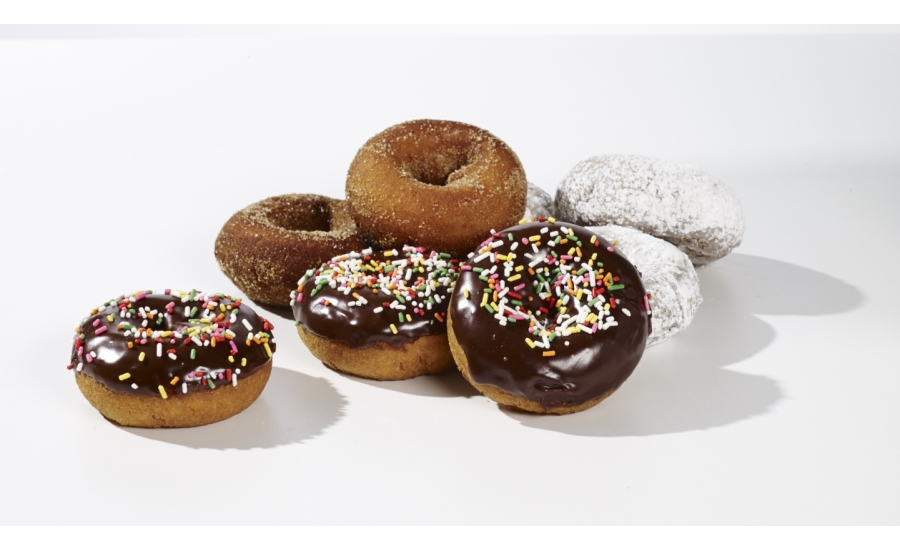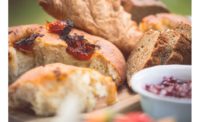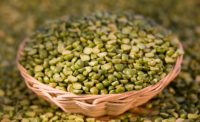During research and development, bakers and snack producers face formulation hurdles on a daily basis. Luckily, functional ingredients like fats, oils, dough conditioners and egg replacers can help them solve a host of common challenges.
Regulatory shift
Bakers who use partially hydrogenated oils (PHOs) in their products face a major challenge due to new government regulations, says Frank Flider, oil consultant, Qualisoy, Chesterfield, MO. “In 2015, the FDA issued a final determination that PHOs are no longer considered to be GRAS (generally recognized as safe),” he explains. “So by June 18, 2018, no food product may contain PHOs without prior FDA approval. Because of the widespread use of PHOs in baking, this ruling has major ramifications. There are hundreds of PHO-based shortenings and margarines used to produce cakes, icings, doughnuts and prepared mixes. Each of these must be replaced by a non-PHO counterpart with a functional equivalent.”
Interesterified high-oleic soybean oil is one PHO replacement option. The oils are produced by esterifying high-oleic soybean oil with fully hydrogenated, conventional soybean oil. “The shortenings can be readily formulated to meet functional requirements of any PHO-based product,” says Flider, adding that Qualisoy is conducting tests to demonstrate their ability to replace PHOs in any food application. “Testing, thus far, has demonstrated that, in every case, high-oleic soybean oil and interesterified high-oleic soybean oil shortenings can replace PHOs with no discernable effect on quality or performance of the finished product.” He notes that since the base component of the shortenings is 100 percent soybean oil, there is a predictable level of availability, price stability and sustainability.
AAK USA Inc., Edison, NJ, also offers a potential PHO-replacement solution for bakers. “Our PHO-free shortenings utilize all available raw materials, such as unique fractions of palm oil and/or palm kernel, coconut blends, soft oils such as canola or high-oleic sunflower/canola oils,” says Monica Zelaya-Brown, customer innovation manager, AAK. “Our portfolio of solutions gives us the capability to easily exchange one base oil for another.”
Zelaya-Brown cites icings as an example of an application impacted by the removal of PHOs. “The biggest challenge is to deliver shortening solutions that are able to incorporate and retain air required for a successful application,” she explains. “The solutions must also be heat-stable to withstand application requirements. We work with customers using a co-development approach to provide the correct amount of solids needed at the whipping stage with stabilizing agents, such as emulsifiers, to provide the ideal crystallization for the application. AAK has formulated and optimized blends with a solid fat content very close to that of commonly used PHOs. These solutions also exhibit rapid melting profiles that contribute to good flavor and mouthfeel.”

Clean-label challenges
Fats and oils can also factor into clean-label stability challenges. According to Chandra Ankolekar, technical manager, Kemin Food Technologies, Des Moines, IA: “Kemin offers an oil-soluble green tea extract that is a suitable replacement for synthetic antioxidants such as TBHQ, BHA and BHT. This extract is soluble in oil and, based on its unique structure, locates itself at the oil/water interface—the hot spot for oxidation.” The label-friendly extract helps slow lipid oxidation and maintain the food’s flavor profile.
For bread bakers, finding a dough conditioner that meets a clean-label standard can be challenging. DuPont’s POWERBake 2550 and POWERBake Natural 2506 are enzymatic dough conditioners designed for clean-label baked goods. “These products contain the latest enzyme technology geared toward improving processing and quality of clean-label products,” says Troy Boutte, group manager, bakery, oils and fats, DuPont Nutrition & Health, New Century, KS. “They work well alone or in combination with other hydrocolloids.”
Egg replacement options
Many bakers and snack producers have explored how to totally or partially replace eggs of late. For some, the solution was using a hydrocolloid, fiber or combination of both. According to Amanda Wagner, food technologist, Fiberstar, River Falls, WI, Citri-Fi, a natural, non-GMO citrus fiber, is often used to partially replace whole eggs—and it can also help reduce oil content. “In baked goods, Citri-Fi has the ability to bind free water throughout the baking process, reducing evaporative loss and retaining moisture content throughout the duration of the product’s shelf life,” she says. Citri-Fi can be labeled as “citrus fiber” and, because it is comprised of fiber, contributes to fiber on the Nutrition Facts panel.
Another functional egg-replacement option is a combination of starches plus protein. Bekabake EF products from ICL Food Specialties, St. Louis, is an ingredient system used to optimize volume, structure and mouthfeel in bakery products. Bekabake EF combines whey protein, pea starch and fiber, and native starch.
Jean Bacardi, regional market segment lead, bakery and beverage, ICL Food Specialties, notes that these products can replace “50 percent of whole egg without sacrificing any shape, volume or texture quality. In some applications, up to 100 percent egg replacement is possible. Bekabake EF can even replace 50 percent of eggs in cheesecake with excellent results.”
High in fiber, low in sugar
As most bakers know, increasing fiber in products to provide a healthier nutrition profile or increase satiety can cause moisture challenges. Fibersol offers a line of ingredients that allows an increase of fiber, in addition to other benefits, without sacrificing taste, aroma or texture. “Fibersol-2 is a soluble corn fiber containing 90 percent concentrated soluble dietary fiber, which can also benefit low-calorie bakery and snack options by functioning similarly to sugar, but has a lower calorie and sugar content,” says Doris Dougherty, technical service representative, ADM, Decatur, IL. “It is used when substituting for table sugar, honey and corn syrup to make a reduced-sugar or no-sugar-added product.”
Reduced-sugar and sugar-free products are garnering more interest from consumers, a trend that may increase if an updated Nutrition Facts label includes the percent daily value for added sugars. Andy Estal, technical director, Beneo Inc., Wilmington, NC, says the company’s chicory fiber can help bakers and snack producers address this issue. “Chicory fiber has some wonderful functionality,” he says. “It acts as a humectant, helping a product to maintain moisture over time, and it adds fiber. What some people don’t know is that it contributes sweetness, so you can reduce sugar while maintaining taste.
“The labeling meets many of the clean-label hurdles—it’s natural, GMO-free and prebiotic,” continues Estal. “We have done many clinical studies proving that chicory root can improve digestive health, contribute to weight management and aid blood sugar management.”

Appealing additions
Bakers seeking a glaze that delivers a uniform, high-gloss coating that resists moisture pickup will appreciate Instant PURE-COTE B792, a modified food starch from Grain Processing Corp., Muscatine, IA. Tonya Armstrong, senior application scientist at the company, notes that the ingredient helps particulates or seasonings adhere to cereals, nuts and snacks.
It can also help improve texture. “If the starch is added to an extruded snack, it will improve crunchiness and expansion of the extruded snack,” says Armstrong. “In a recent cracker study at AIB International, Instant PURE-COTE B792 was tested to see if it helped machinability, crispiness and crunchiness of a whole-grain cracker. The product was tested at two usage levels against a cracker using an unmodified corn starch and a control. AIB measured texture with a TA-TX plus texture analyzer. At both starch levels, the Instant PURE-COTE B792 crackers were significantly crispier and crunchier than either the control or the sample with unmodified corn starch.”
Bakers also want the fruit in their products to smell authentic. Donnie Moran, national sales manager, Prinova, Carol Stream, IL, says the company’s FlavorArmor is “unique because of the manufacturing process, which enhances the functionality. This product provides an authentic aroma that more closely mimics the target flavor and is more authentic than spray-dried flavors. It is natural, nonallergenic and nonhydrophobic.”
Healthy and long-lasting
Acrylamides were first discovered to be an issue in baked, fried and broiled foods in 2002, raising concerns among health regulators. “Any food that contains the amino acid asparagine and reducing sugars (carbohydrates), and that is cooked above 120°C, contains some amount of acrylamide,” says Matthew Dahabieh, Ph.D., president, Renaissance Ingredients Inc., Vancouver, British Columbia. “The concern is that acrylamide is a known carcinogen.”
Renaissance Ingredients has a baker’s yeast that is bred to reduce the amount of acrylamide in a variety of foods. “As an ingredient, this AR yeast can be used exactly the same as conventional baker’s yeast,” Dahabieh says. “Alternatively, it can be mixed into savory snack foods, and it will degrade asparagine upon contact.”
Extending the shelf life of baked good and snacks can help preserve their eating quality or maintain food safety. From a food-safety perspective, DuPont Nutrition & Health has a variety of antimicrobial products for baked goods and snack foods. According to John Wyatt, product manager, the company has a full line of products, including Natamax B Plus, MicroGARD 910 and MicroGARD210. “These products are able to maintain the characteristic and desired flavors for shelf-life extension,” he says. “They also help meet today’s requirements for ingredient replacement and simpler labels.”
Bakers working with gluten-free breads face challenges related to desired volume. According Mark Hines, Ph.D., global program manager, Ashland Specialty Ingredients, Covington, KY, modified cellulose—sometimes called hydroxypropyl methylcellulose (HPMC) —is very effective at providing functionality close to the gluten in wheat flour. Hines explains that the cellulose “thermally gels during baking to maintain volume and gas cell structure, resulting in bread with a fine, even crumb, high volume and low density. Additionally, HMPC controls water migration and maintains texture over shelf life.” Modified cellulose can be combined with rice flours and starches to achieve the desired end product characteristics.





